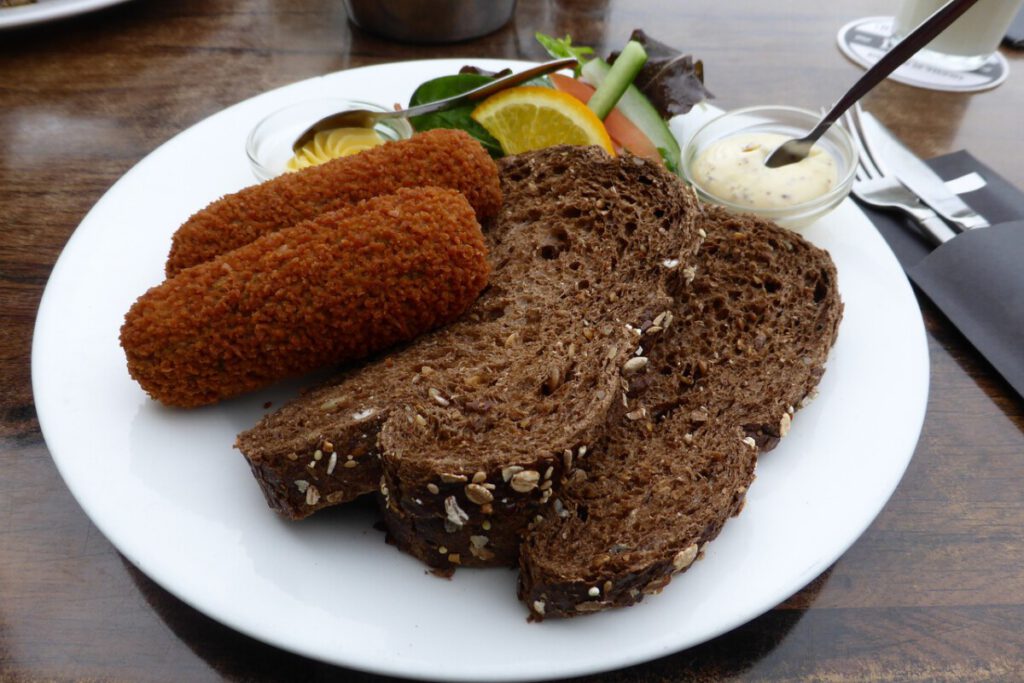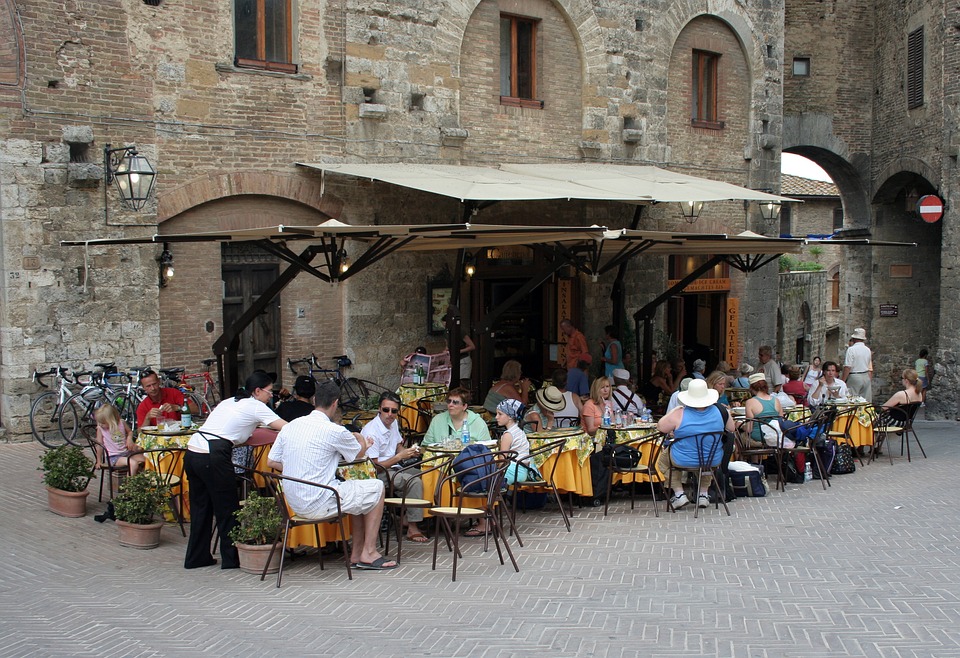It’s your first day at work as an international, and you are about to enjoy lunch with your Dutch colleagues. You reach the cafeteria, only to be shocked that what is on the menu is, well, just a sandwich.
Oh, it’s also completely overpriced and doesn’t even contain that many ingredients. Enjoy!
As an expat in the Netherlands, Dutch lunch customs might seem strange. Why is the munch so minimalist? Does it just take some getting used to, like the wonderfully bleak Dutch weather?
We’ve done some meal prepping for all you need to know about having lunch in the Netherlands.
Sandwiches served with a slice of history
The Dutch love for sandwiches — be it as broodjes or boterhams — comes from a much older, ancestral love for bread. Even in the 17th century, bread was a hot topic (or should we say toasty topic 😉) in the Netherlands.
A staple food even back then, bread was enjoyed with cheese or butter during breakfast, then with meat or hutspot (a dish combining meat and vegetables) for lunch, and finally with porridge in the evening. 😋
Bread was such an integral part of society that different types could symbolise different social statuses. The working class consumed bread made out of coarse wheat or rye, while the rich ate white bread.

This is serious stuff: the government even appointed brood-wegers (bread weighers) who inspected bakers’ bread to ensure the perfect size, weight, ingredients, and bake.
They ought to leave no crumbs — bakers not following the right procedures would get a hefty fine. 💸
READ MORE | Dutch Quirk #68: Carry an emergency krentenbol everywhere they go
If bread has been bred as a building block of Dutch society, then sandwiches are the fully-baked masterpiece. You can check out some of DailyDutchLunch‘s posts for the fun reality of sandwich art in the Netherlands.
Or feast your eyes on our video about the ultimate Dutch sandwich:
Get (b)ready for lunch culture in the Netherlands
Get a “loaf” of this — the days of the Dutch Golden Age may be over, but the bread culture keeps growing, and nowadays, a wide assortment of sandwiches is available.
Usually, the Dutch tuck into lunch around midday, which lasts between 30 minutes and an hour, though this varies per workplace. Feeling extra productive? Sandwiches are handy for a 15-minute desk lunch, too. ⏰
READ MORE | Dutch Quirk #5: Eat cheese every day for lunch

Lunch is a moment of social gathering, as co-workers flock together to eat and socialise. In canteens at workplaces, one of the few warm meals you can usually get besides the cold Protestant sandwiches (a.k.a. bread with butter and ham or cheese) is soup. ♨
Some people might also bring lunch packed from home, which — as you might have already guessed — is probably a sandwich.
READ MORE | Dutch Quirk #116: Have a great work/life balance
Well, one reason their lunch is on the lighter side is to maintain productivity and return to work feeling energised. After all, we know what it feels like when you eat big, only to enter a food coma for the rest of the afternoon. 😴
We’re looking at you, Southern Europeans. 👀⌚
How does Dutch lunching compare to other European countries?
Consider the Italians. Their lunch break is two hours long, usually from 1 PM until 3 PM. Most shops close at this time, and the lunch is an all-in, two-course, communal experience complete with something sweet before coffee.

The French have a similarly extravagant lunch culture. It’s not uncommon to have a four-course meal, and lunch is considered a celebratory moment of food and socialising with friends. 🍽
In the end, perhaps it is all just a trade-off — who is getting more work done? The French and Italians might eat rich, have nicer weather and a joie de vivre attitude, but are they efficient? Do their trains arrive on time? Wait, never mind…
It’s just up to how each country rolls. If the Dutch didn’t have bad weather and weren’t constantly fighting the seas, they wouldn’t be the country they are now. Maybe they would have better lunch options, but hey, who are we to turn down bread with margarine?
We’re not “baking” it up, here’s what you said
In order to get to the bottom of lunch culture in the Netherlands, we asked some of our readers from our awesome Facebook group about their experiences. Here are some of our favourite answers:
Our own Bobby Salomon, from Amsterdam, toasted the efficiency argument:
“Because there’s no time, it costs too much, it’s difficult to bring and/or keep warm if you make it yourself and — personally — I’m really uncomfortable with a warm stomach if I still have to do stuff after.”
Kostas from Greece, home of one of the best global cuisines, shares the understanding that a heavy lunch and productivity don’t mix:
“Dutch food has influences from nice cuisines, and contrary to what you may think, Dutch people really enjoy food. Lunch is usually something more light and fresh because they take lunch really early as well as dinner and therefore do not prefer heavy things when taking a break then going back to work four hours or so.”
Finally, Kenneth wanted to know:
“The next question should have been ‘Why did the Dutch people raid the whole world for spices hundreds of years ago only for their descendants not to use them?'”
Great question.
That ties up our article on Dutch lunch, and we wholeheartedly suggest that you should go and get yourself a boterham in celebration. Remember, you are not eating just bread with ham, you are getting a taste of true culture!
Do you have a favourite Dutch sandwich? Tell us in the comments below!





Even though I lived in the Netherlands for only 12 of my 81 years I was raised with Dutch cooking. As far as sandwiches go, they were always open faced when eating at home. I never had bread with porridge, but remember having to eat it as a dessert ( yuck) and never had it with hutspot either. I like oatmeal porridge here in Canada cooked in water and thick, the one from my youth was cooked in milk and not very thick ( read slimy) I hated it and ate it with a pinched nose.
A born & raised proud to be Dutch girl, I love sandwiches!!! No cheese though, but lunchMeat, especially liverwurst (smeerworst) or cheese spread (smeerkaas. I also love filet americain… Not just for lunch, but breakfast as well and sometimes dinner, like on a Saturday with soup!!! ❤️??
I lived in The Netherlands for the first 30 years of my life. I no longer eat bread or lunch but the best lunch I can think of, is dark Dutch or European bread with medium/old Gouda cheese. I can’t think of anything tastier.
I grew up in The Netherlands eating bread for breakfast and lunch. On there: hagelslag, cheese, jam or lunchmeat ( leverworst and filet americain as favorites). Having moved to the US after over 50 years, I still eat bread for breakfast and lunch. It’s not just easy and fast but a lot healthier than a lot of other options! Broodje gezond and tijgerbrood are my favorites! I’ve always wondered if the love of bread and dairy makes the Dutch so tall…..😉
If you have a speculaas sandwich you’ve got every spice available on your bread. Speculaas kruiden contain most tropical spices. Just sayin’……
Grilled cheese sandwich, can’t be beat. I’ll use Gouda, Colby or a combination of the two lighty grilled in extra virgin olive oil, dipped in ketchup or a ketchup mayonnaise combination.
It’s a matter of getting used to eating sandwiches, it’s actually a light meal and definitely keeps the lethargic feeling away . Have lived here for 10 years and it rocks!
I think you mean “stampot” and not “hutspot”. But even then, it’s not common to eat it with bread. I’m always curious how foreign journalists get those weird information.
As a person deeply interested in the Netherlands and as Italian I find the second half of this article highly debatable if not ridicolous, for it’s only based on misconceptions. Lunch breaks in Italy usually lasts from half an hour to an hour. France may not have neat sandwiches but it has atomic bombs. Both countries have an international standing that the Netherlands doesn’t have. Having said this, the rest of the article is quite interesting.
Left Holland in my 20″s, in the 1950″s, recently took one of my sons for an extended visit, he was totally fascinated by all the toppings the dutch have, a tablefull of meats, cheeses, herring, and of course chocolate, a trip to Albert Hein was an adventure. It is now the request for casual get togethers of a large family.
Hey man,
japanese people don’t eat sandwiches for lunch (and drink milk aside 🙂 ).
Japanese have also complex recipes that take a couple of days to be completed.
Born and bred Dutch lass here, I have never heard of eating hutspot with bread. I think you meant stoofpot (a meat based stew) because you don’t mention the hutspot having potatoes as a main ingredient. Same for eating bread with porridge, no one does that here. Having bread for an evening meal, yes, that’s quite common, usually accompanied with a salad or soup. In the olden days (think 1940/50) it was quite normal to have a hot meal for lunch. I believe that to this day in certain regions and families that is still the case, especially the older generation will still have a hot lunch. I remember visiting my grandparents in the 70ies and 80ies and we would have potatoes, meat and veg for lunch and a lighter evening meal.
Having a kantine at work, as in one that provides lunch to buy, isn’t standard in The Netherlands imho, especially for smaller companies.
I agree with the comment by Koos on foreign journalists and their sources, because a lot of the time I question where they get their info from when it’s about so-called favourite Dutch foods. I once read that apparently salty liquorice is our favourite movie snack??? Maybe for a tiny minority, but definitely not for the majority of the Dutch.
As Italian, I think that some of the information shared about Italy are not correct, since our lunch break lasts up until one hour and that we usually eat only one course.
Moreover, the duration of lunch doesn’t affect productivity: when I worked in Milan, the job was very intense, so it was nice to have a hour to recharge before starting again.
And we don’t need to take land from water, since we have enough space for everybody I guess.
Apart from these things, the rest of the article was interesting, especially the historical facts and traditions.
My parents were born and raised in Holland. Came to the US in 1928. I was therefore raised in a very Dutch home We ate all the things you mentioned including Hutsput. I am now 86 years old and I still eat a sandwich everyday for lunch. And it is always ham and cheese. (Must be in the genes!) My favorite cheese is Leitsa Kansas. (Leyden cheese)
One of your readers noted that ‘Why did the Dutch people raid the whole world for spices hundreds of years ago only for their descendants not to use them?’” This comment is absolutely false. As a result of the spice trade hundreds of years ago, the Dutch have so e of the best Indonesian cuisine in the world. Where do you think the word ‘rijsttafel’ originates from? Indonesian cuisine is a very common dinner specialty in the Netherlands. And, yes, many of the dishes have the spices that were originally imported hundred of years ago. Besides, the Dutch have been known to dap a little Sambal Oelek into some of their own native dishes on occasion to give it a bit more kick.
Hutspot is a dish made out of potatoes, onions and carrots as the main ingredients. You can serve it with a sausage on the side.
Came to the U.S. when I was 5 returned quite often do visits . We always had our main meal at noon with potatoes meat vegetables and yogurt or puddings for desert… breakfast yes lots of breads and dark rye with cheese sometimes hard boiled eggs jams fresh fruit too… and our meal at 6 o’clock breads cheese fish sometimes…. We came from a farming background in Friesland so we needed energy throughout out the day… we also had a coffee break always at 10:00 am with cakes cookies etc. and tea at 4:00 with cookies etc. also my grandfather would bring out a beer or drink at 8:00 sometimes at night… we were always eating😱
I remember when I moved to Holland in 1983 after eight years in Geneva – a French-speaking culture with cuisine to match – I was horrified to find not only that Dutch ‘lunches’ were so paltry (breakfast 0.2) but that you were expected by employers to take no longer than half an hour’s break at midday. I’ve never got used to this, and eventually stopped eating lunch here altogether. Around the time I moved to Holland, something of a culinary revolutionary did begin to emerge here, and it’s now possible to find places not only open around lunchtime, but even serving stuff other than the regulation sandwiches and packeted soups (Royco). But the emphasis even today is on bread, soup and basic salads. Perhaps it’s Calvinistic parsimony (even in the Catholic-ethos south, where I live), but I still can’t get my head round it. I remember business meetings in the eighties and nineties with guests from other parts of Europe, who were likewise stunned to break for ‘lunch’ and find themselves dished up with plates of plain ham and cheese sandwiches on spongy white bread spread with cheapo margarine rather than real butter (as the Dutch actually called it – ‘echte boter’), and the inevitable COFFEE with the no less inevitable ‘koffiemelk’ (no alcohol, please, we’re Dutch!)
I’m in Holland right now. Haarlem and Amsterdam for a week. I literally cannot find anything edible. I tried bitterballen today , it was awful. Everything else looks terrible. Subsisting on market fruit, cheese, bread. Can’t get a good cup of coffee. They consider four ounces a normal size. It’s a beautiful country but I can never come back if there is nothing to eat. Nothing but plain sandwiches, French fries, weird salads, rich cakes, and beer. Even the breakfasts are nothing.
May I ask which country you come from and what you usually eat for breakfast, lunch and dinner?
I want a sandwich.I would love that idea.
After 7 years of living in south Limburg I have never known a country have such basic, tasteless food. Yes, sandwiches, they are just open with piled up standard stuff on them. Utterly basic, not tasty, expensive. I just paid €50 for two breakfast sandwiches, (ham, (tasteless and three eggs), two cappuccinos, water and a piece of cake to take away. None of it tasted good and the waitress was very unhelpful and slow. I knew there was no point in complaining, as after 7 years I know I will just be told how wrong I am. I was not in the mood for the Dutch stubbornness and ego today. Was it Lekker, was it hell. Counting the days until I can eat a proper cuisine
again, when I have left. With kinder people who care about customer service.
Maybe people in Zuid Limburg have not travelled and lived abroad as much as me, at 60 I have spent a lot of time in many interesting countries. I feel I have the experience here to have a valid opinion, unlike some of these not so well travelled or open minded locals.